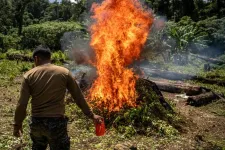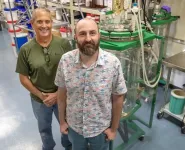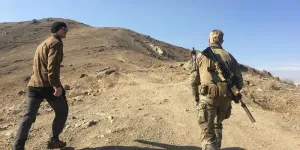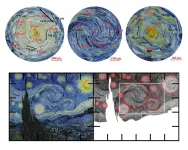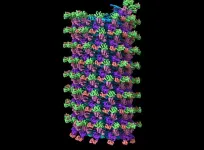(Press-News.org) COLUMBUS, Ohio – For many decades, the coca plant – the main ingredient in cocaine – has been grown almost exclusively in South America. But a new study shows that nearly half of northern Central America appears to be highly suitable for cultivating this lucrative cash crop.
Findings showed that 47% of Honduras, Guatemala and Belize have the right climate and soil for commercial coca growing. Most of southern Central America was not suitable.
It’s not a hypothetical concern. Researchers began the study after seeing media reports and press releases about coca eradication operations by police and military forces in several Central American countries.
“South America’s long monopoly on coca production for the international cocaine market is over,” said Kendra McSweeney, corresponding author of the study and professor of geography at The Ohio State University.
“That’s a very significant development in the dynamics of the cocaine trade.”
The study, published today (Sept. 17, 2024) in the journal Environmental Research Letters, was led by Paulo J. Murillo-Sandoval of the Universidad del Tolima in Colombia.
For now, coca growing in Central America appears to be rare and scattered in remote areas, McSweeney said. But this study suggests it has the potential to become more widespread, especially under business-as-usual drug policies.
The researchers drew data from press releases and media reports of 55 separate coca eradication operations in Central America from 2017 through 2022.
McSweeney and her colleagues mapped the approximate locations of each coca field cluster. Next, they used digital data on combined soil, climate and topographic factors that might favor or limit coca farming in those areas. They then used machine-learning models to compare these Central American locations to known coca-growing sites in Colombia.
“This is the kind of assessment that researchers do routinely for standard crops. To see, for example, can soy be grown in this part of Brazil?” McSweeney said.
“But we wanted to know if this illegal crop could be grown in an area where we don’t think it has been grown until recently. And it turns out it is great for growing coca. It’s ideal.”
While nearly half of northern Central America has the right biophysical characteristics to grow coca, a question is why criminal groups are growing coca there at all, given the current coca surplus in South America.
There are no definitive answers, the authors said, but there are some possible theories. Murillo-Sandoval indicated that the end of the armed conflict in Colombia since 2016 leveraged new ideas about how the coca business can be managed. One new way is to explore the potential of growing coca nearer to northern markets, including the United States.
Also, there are a variety of precursor chemicals that are needed to turn coca into cocaine, and those chemicals are less regulated in Central America than they are in Colombia.
Another advantage to Central America is that growing coca there would allow traffickers to avoid Coast Guard interdiction of boats smuggling cocaine north out of South America, shortening the supply chain for traffickers based in Mexico.
“It would be much more convenient and cheaper for them to buy cocaine produced right next door in Guatemala, than have it shipped from Colombia,” McSweeney said. “It is an economic and strategic decision.”
McSweeney said she and her colleagues discussed whether they should publish these results because of ethical concerns.
They were concerned about possibly providing information that could be helpful to organized criminal networks involved in growing coca. They also worried that police and military in Central America could use the information to target law enforcement at the rural communities unlucky enough to be located near coca plantations, and who might erroneously be assumed to be involved, McSweeney said.
But their Central American co-author and collaborators in the region encouraged publication of the research and said that the general public had a right to know and discuss the findings, so they can be prepared.
“The citizens there need to know how big this industry could become. As for the criminals, they’re way ahead of us—they already know about Central America’s agricultural suitability. They’ve been testing growing conditions in multiple countries for years,” McSweeney said.
McSweeney emphasized that coca plantations are still rare in northern Central America, and the researchers are not predicting where coca will be grown in the future. They stress that the coca industry’s future in Central America will depend in part on how the countries involved respond to the current threat.
Murillo-Sandoval said he knows from Colombia’s experience that eradication of coca plantations doesn’t work. It only spreads coca-growing to new areas. McSweeney and colleagues’ previous work has also shown that at-sea interdiction of drug shipments is equally counter-productive. In the conclusion to the current study, the researchers urge drug policy analysts and policymakers to consider novel policy and law-enforcement approaches.
Current supply-side approaches to the drug war that rely heavily on law enforcement raids and destruction of growing operations simply encourage criminals to move their operations elsewhere – a dynamic that has played out in South America for decades. McSweeney said, adding that this study shows that Central America is at risk of becoming one of the next places for these destructive dynamics to take root.
“We need to find new ways to battle the drug problem that don’t encourage this outcome,” she said. “The solutions don’t all lie in Central America. We have to re-think our drug policies at home, too.”
Other co-authors of the study were Steven Sesnie of the U.S. Fish and Wildlife Service; Manuel Eduardo Ordoñez Armas of Guatemala; Nicholas Magliocca of the University of Alabama; Beth Tellman of the University of Arizona; Jennifer Devine of Texas State University; and Erik Nielsen of Northern Arizona University.
END
Central America could play troubling new role in cocaine trade
Study finds some countries agriculturally “ideal” for growing coca
2024-09-17
ELSE PRESS RELEASES FROM THIS DATE:
SwRI and UTSA will create synthetic process for antibiotic drug discovery
2024-09-17
SAN ANTONIO — September 17, 2024 —Southwest Research Institute (SwRI) is collaborating with The University of Texas at San Antonio (UTSA) to explore and develop a novel platform or chemical process for synthesizing antibiotic compounds with a $125,000 grant. The project, one of two winning proposals this cycle, is supported by the Connecting through Research Partnerships (Connect) program designed to foster collaboration between SwRI and UTSA.
“SwRI and UTSA will work together to combat the growing threat antimicrobial resistance poses to global health by developing a proof-of-concept platform to potentially create a whole ...
Norwegian Afghanistan veterans more prone to anger
2024-09-17
From 2001 to 2021, roughly 9200 Norwegian soldiers served in Afghanistan. The vast majority of them have managed well in the years that have followed. According to a new survey conducted by the Norwegian Armed Forces Joint Medical Services, however, a significant number of the veterans struggle with mental health issues.
“All Norwegian veterans who served in Afghanistan were invited to participate in a large health survey in 2020,” says Associate Professor Andreas Espetvedt Nordstrand at the Norwegian University of Science and Technology ...
Black hole pairs may unveil new particles
2024-09-17
In a paper published in Physical Review Letters this week, physicists from Amsterdam and Copenhagen argue that close observations of merging black hole pairs may unveil information about potential new particles. The research combines several new discoveries made by UvA scientists over the past six years.
Gravitational waves that are emitted by the merger of two black holes carry detailed information about the shape and evolution of the orbits of the components. A new study by physicists Giovanni Maria Tomaselli and Gianfranco Bertone from ...
Amsterdam UMC led research sets a step forward in the battle against MRSA
2024-09-17
Staphylococcus aureus, mostly known from its antibiotic-resistant variant Methicillin-resistant Staphylococcus aureus (MRSA), is among the leading causes of both community- and hospital-acquired infections. According to the most recent data, MRSA killed around 120,000 people in 2022 globally and far more are killed by antibiotic-susceptible strains of S. aureus. So far however, all attempts at developing a protective vaccine for S. aureus have been unsuccessful. Research from Amsterdam UMC, in collaboration with UMC Utrecht, Leiden University, and the University of California, San Diego, have discovered an important immune component that offers protection against infection, ...
Childhood trauma linked to major biological and health risks
2024-09-17
A new study led by UCLA Health found that a person’s sex and their unique experiences of childhood trauma can have specific consequences for their biological health and risk of developing 20 major diseases later in life.
Although a large body of research has shown that childhood adversity can have long-lasting impacts on a person’s biology and health, there has been little research looking into how different types of stressors affect specific biological functions and health risks.
The new findings, published in the journal ...
Beneath the brushstrokes, van Gogh’s sky is alive with real-world physics
2024-09-17
WASHINGTON, Sept. 17, 2024 – Vincent van Gogh’s painting “The Starry Night” depicts a swirling blue sky with yellow moon and stars. The sky is an explosion of colors and shapes, each star encapsulated in ripples of yellow, gleaming with light like reflections on water.
Van Gogh’s brushstrokes create an illusion of sky movement so convincing it led atmospheric scientists to wonder how closely it aligns with the physics of real skies. While the atmospheric motion in the painting cannot be measured, the brushstrokes can.
In an article published this week in Physics ...
Excess body weight and the risk of second primary cancers among cancer survivors
2024-09-17
About The Study: In this cohort study of older survivors of nonmetastatic cancer, those who had overweight or obesity at the time of their first cancer diagnosis were at higher risk of developing a second cancer, especially an obesity-related second cancer. Given the high prevalence of overweight and obesity among cancer survivors, it is important to promote survivorship care guidelines recommending weight management and increase awareness of second cancers among physicians and cancer survivors.
Corresponding author: To contact the corresponding author, Clara Bodelon, Ph.D., M.S., email clara.bodelon@cancer.org
To access the embargoed study: Visit our For The ...
Outcomes by race and ethnicity following a Medicare bundled payment program for joint replacement
2024-09-17
About The Study: This cohort study shows that the Comprehensive Care for Joint Replacement program outcomes differed by race and ethnicity for patients covered outside traditional Medicare, with home discharge rates increasing more for Hispanic compared with non-Hispanic white patients. These findings suggest the importance of considering differential outcomes of Medicare payment policies for racial and ethnic minority patient populations beyond the initially targeted groups.
Corresponding author: To contact the corresponding author, Narae Kim, Ph.D., ...
LJI discovery paves the way for antivirals against Ebola virus and its deadly relatives
2024-09-17
LA JOLLA, CA—At this moment, the world has few tools to combat deadly filoviruses, such as Ebola and Marburg viruses. The only approved vaccine and antibody treatments protect against just one filovirus species.
Scientists at La Jolla Institute for Immunology (LJI) are working to guide the development of new antivirals by leading some clever enemy reconnaissance. These researchers use high-resolution imaging techniques to examine a virus's molecular structure—and uncover where a virus is vulnerable to new therapies.
In a new Cell study, scientists in LJI's Center for Vaccine Innovation share the first ...
Advanced 3D mammography detects more breast cancers, fewer false positives
2024-09-17
New Haven, Conn. — The newer, 3D form of breast screening, known as digital breast tomosynthesis (DBT), is more effective at detecting breast cancer than traditional 2D digital mammography (DM). That’s the conclusion of an analysis of 13 years’ worth of screening data conducted by Yale Cancer Center researchers. The data also suggests that 3D mammograms could reduce the incidence of advanced cancer diagnoses.
“Most of the time, women will do better with 3D mammograms since their ...
LAST 30 PRESS RELEASES:
Numbers in our sights affect how we perceive space
SIMJ announces global collaborative book project in commemoration of its 75th anniversary
Air pollution exposure and birth weight
Obstructive sleep apnea risk and mental health conditions among older adults
How talking slows eye movements behind the wheel
The Ceramic Society of Japan’s Oxoate Ceramics Research Association launches new international book project
Heart-brain connection: international study reveals the role of the vagus nerve in keeping the heart young
Researchers identify Rb1 as a predictive biomarker for a new therapeutic strategy in some breast cancers
Survey reveals ethical gaps slowing AI adoption in pediatric surgery
Stimulant ADHD medications work differently than thought
AI overestimates how smart people are, according to HSE economists
HSE researchers create genome-wide map of quadruplexes
Scientists boost cell "powerhouses" to burn more calories
Automatic label checking: The missing step in making reliable medical AI
Low daily alcohol intake linked to 50% heightened mouth cancer risk in India
American Meteorological Society announces Rick Spinrad as 2026 President-Elect
Biomass-based carbon capture spotlighted in newly released global climate webinar recording
Illuminating invisible nano pollutants: advanced bioimaging tracks the full journey of emerging nanoscale contaminants in living systems
How does age affect recovery from spinal cord injury?
Novel AI tool offers prognosis for patients with head and neck cancer
Fathers’ microplastic exposure tied to their children’s metabolic problems
Research validates laboratory model for studying high-grade serous ovarian cancer
SIR 2026 delivers transformative breakthroughs in minimally invasive medicine to improve patient care
Stem Cell Reports most downloaded papers of 2025 highlight the breadth and impact of stem cell research
Oxford-led study estimates NHS spends around 3% of its primary and secondary care budget on the health impacts of heat and cold in England
A researcher’s long quest leads to a smart composite breakthrough
Urban wild bees act as “microbial sensors” of city health.
New study finds where you live affects recovery after a hip fracture
Forecasting the impact of fully automated vehicle adoption on US road traffic injuries
Alcohol-related hospitalizations from 2016 to 2022
[Press-News.org] Central America could play troubling new role in cocaine tradeStudy finds some countries agriculturally “ideal” for growing coca
